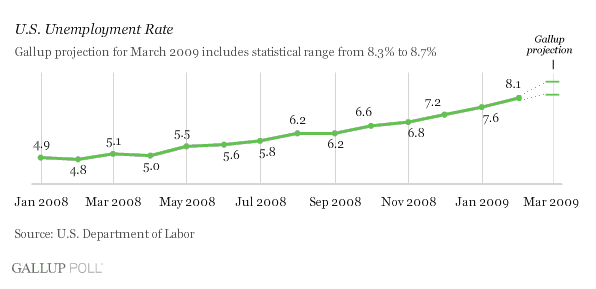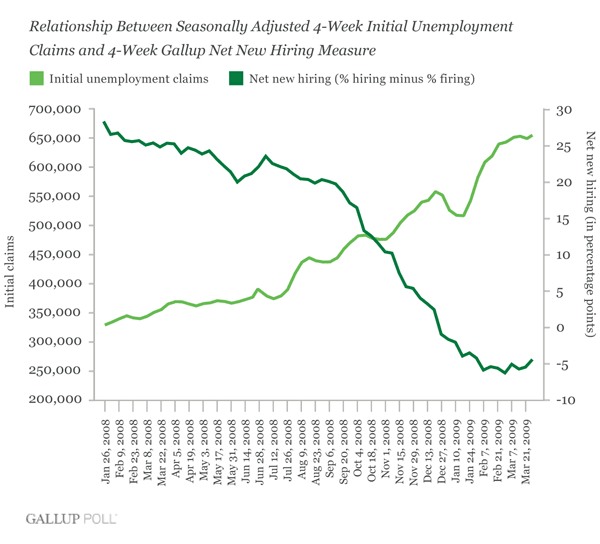PRINCETON, NJ -- Gallup's projection, based on its Net New Hiring Index, suggests the March 2009 unemployment rate is likely to reach at least 8.3% -- and could go as high as 8.7% -- when the Labor Department reports it on Friday. This would further augment the remarkable two percentage-point increase seen between September 2008 and February 2009, including nearly a full point between December and February.

Unemployment Continues to Worsen
Gallup's unemployment-rate model -- based on its four-week average Net New Hiring measure (the percentage of employees saying their companies are hiring minus the percentage saying their companies are letting people go) -- was -5 in March, which is essentially unchanged from the -6 of February and the -4 of January. All three are substantially worse than the +25 score of March 2008.
The unemployment rate has been increasing recently, while Gallup's Net New Hiring measure has been negative but also stable. Statistical models based on the relationship between these two indicators show that no change in the Net New Hiring measure predicts continued increases in the unemployment rate. This is also consistent with the government's report on Thursday that seasonally adjusted four-week average jobless claims hit a 26-year high of 656,750 in the week ending March 28 and continuing claims hit 5.73 million.
The monthly trend in Gallup's Net New Hiring measure is inversely related to the U.S. unemployment rate and, based on its 15-month history, the measure provides Gallup with a better than 8-in-10 chance of accurately estimating the unemployment rate's future direction.

Each month, Gallup conducts more than 8,000 interviews with U.S. employees, to ascertain their perceptions of the job situation at their companies. Of course, many factors make such unemployment-rate projections difficult, with probably the most important of these being the potential for job seekers to get discouraged and stop looking for work (and thus not be included in the government's official unemployment rate). As the job situation worsens, the size of the labor force often shrinks, reducing the percentage reported as unemployed.
Job Market: Leading or Lagging Indicator?
The unemployment rate has traditionally been regarded as a lagging economic indicator. Essentially, it simply measures the fallout of the U.S. economy's overall direction, whether positive or negative. As a result, the continuing plunge in the jobs market is both expected and discounted as a predictor of future economic activity.
However, this recession is not like the others of the post-World War II period. Right now, in this consumer-driven downturn, one of the major factors keeping consumers from borrowing and spending is the fear of job losses. The auto company promotions promising continuation of monthly payments for consumers who buy a new car and then lose their jobs are emblematic of this fear on the part of the potential car-buying consumer.
As a result, the worsening jobs situation is likely to reinforce consumer tendencies to pull back on spending. It could also lead lenders to raise their lending standards even more as they try to avoid increased consumer credit losses. Further, businesses currently in survival mode might see the persistent deterioration of the jobs market as a sign that consumer spending will continue to worsen. In turn, they may continue to reduce inventories, cut capital spending, and let even more people go, continuing a vicious downward spiral. In this sense, the jobs market may now serve as a leading indicator of when consumers' fear of losing their jobs will begin to moderate. And, signs of such a moderation could be a huge plus for the U.S. economy.
Whether the unemployment situation is a leading, lagging, or coincident economic indicator, Gallup's Net New Hiring Index will continue to provide daily and weekly monitoring of the important and changing conditions in today's jobs market.
Survey Methods
Gallup's hiring measure is based on aggregated interviews with a nationally representative sample of more than 8,000 U.S. workers each month. Gallup asks current full- and part-time employees whether their employers are hiring new people and expanding the size of their workforces, not changing the size of their workforces, or letting people go and reducing the size of their workforces. Gallup's hiring measure is computed by subtracting the "letting go and reducing" percentage from the "hiring and expanding" percentage. The assumption is that employees across the country have a good feel for what's happening in their companies, and that these insider perceptions can yield a meaningful indication of the nation's job situation. For results based on these samples, the maximum margin of sampling error is ±3 percentage points.
Interviews are conducted with respondents on land-line telephones (for respondents with a land-line telephone) and cellular phones (for respondents who are cell-phone only).
In addition to sampling error, question wording and practical difficulties in conducting surveys can introduce error or bias into the findings of public opinion polls.
